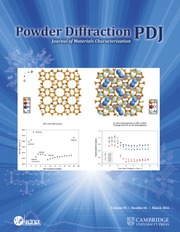No CrossRef data available.
Article contents
Standardless quantification of crystalline polymorphic mixtures using the component decomposition method
Published online by Cambridge University Press: 20 June 2025
Abstract
We developed a method called “component decomposition” to extract the pattern of each component of the sample from the multiple powder X-ray diffraction data. Using the component decomposition and the Direct Derivation Method™, we analyze the behavior of phase transitions of trehalose during the changes in temperature and humidity. Because we do not require databases or standard samples, this method is a powerful tool for the quantification of polymorphs in samples containing multiple polymorphs.
Keywords
Information
- Type
- Proceedings Paper
- Information
- Copyright
- © The Author(s), 2025. Published by Cambridge University Press on behalf of International Centre for Diffraction Data
References
REFERENCES
Nagase, Hiromasa 2005. “Elucidation of Stabilizing Mechanism of Saccharides on Biomolecules and Its Application.” Proceedings of the Hoshi University 47: 1–9.Google Scholar
Nagase, H., Endo, T., Ueda, H., and Nagai, T.. 2003. “Influence of Dry Conditions on Dehydration of α,α-Trehalose Dihydrate.” STP Pharma Sciences 13: 269–75.Google Scholar
Nagase, Hiromasa, Endo, Tomohiro, Ueda, Haruhisa, and Nakagaki, Masayuki. 2002. “An Anhydrous Polymorphic Form of Trehalose,” Carbohydrate Research 337: 167–73.CrossRefGoogle ScholarPubMed
Paatero, Pentti, and Tapper, Unto. 1994. “Positive Matrix Factorization: A Non-Negative Factor Model with Optimal Utilization of Error Estimates of Data Values.” Environmetrics 5 (2): 111–26.CrossRefGoogle Scholar
Reisener, H. J., Goldschmid, H. R., Ledingham, G. A., and Perlin, A. S.. 1962. “Formation of Trehalose and Polyols by Wheat Stem Rust Uredospores.” Canadian Journal of Biochemistry and Physiology 40: 1248–51.CrossRefGoogle Scholar
Sussich, Fubiana, Skopec, Catherine, Brandy, John, and Cesaro, Attilio. 2001. “Reversible Dehydration of Trehalose and Anhydrobiosis: From Solution State to an Exotic Crystal?” Carbohydrate Research 334: 165–76.CrossRefGoogle Scholar
Toraya, Hideo 2016. “A New Method for Quantitative Phase Analysis Using X-Ray Powder Diffraction: Direct Derivation of Weight Fractions from Observed Integrated Intensities and Chemical Compositions of Individual Phases.” Journal of Applied Crystallography 49: 1508–16.CrossRefGoogle Scholar
Toraya, Hideo 2024. “Basic Theory and Applications of the Direct Derivation Method for Quantitative Phase Analysis Using X-Ray Diffraction Techniques.” Advances in X-Ray Chemical Analysis, Japan 55: 35–55.Google Scholar


